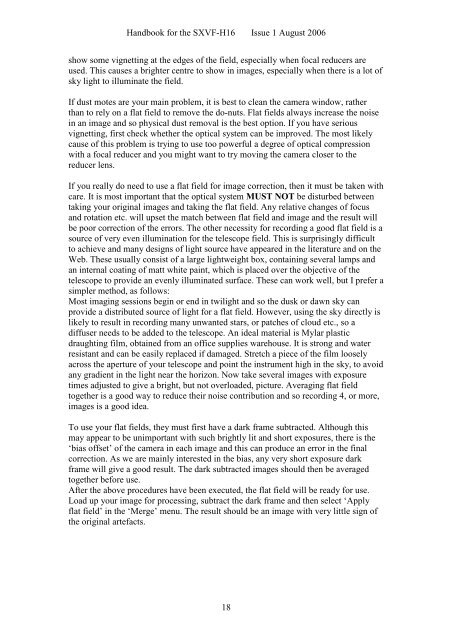SXVF-H16 handbook.pdf - Starlight Xpress
SXVF-H16 handbook.pdf - Starlight Xpress
SXVF-H16 handbook.pdf - Starlight Xpress
You also want an ePaper? Increase the reach of your titles
YUMPU automatically turns print PDFs into web optimized ePapers that Google loves.
Handbook for the <strong>SXVF</strong>-<strong>H16</strong> Issue 1 August 2006<br />
show some vignetting at the edges of the field, especially when focal reducers are<br />
used. This causes a brighter centre to show in images, especially when there is a lot of<br />
sky light to illuminate the field.<br />
If dust motes are your main problem, it is best to clean the camera window, rather<br />
than to rely on a flat field to remove the do-nuts. Flat fields always increase the noise<br />
in an image and so physical dust removal is the best option. If you have serious<br />
vignetting, first check whether the optical system can be improved. The most likely<br />
cause of this problem is trying to use too powerful a degree of optical compression<br />
with a focal reducer and you might want to try moving the camera closer to the<br />
reducer lens.<br />
If you really do need to use a flat field for image correction, then it must be taken with<br />
care. It is most important that the optical system MUST NOT be disturbed between<br />
taking your original images and taking the flat field. Any relative changes of focus<br />
and rotation etc. will upset the match between flat field and image and the result will<br />
be poor correction of the errors. The other necessity for recording a good flat field is a<br />
source of very even illumination for the telescope field. This is surprisingly difficult<br />
to achieve and many designs of light source have appeared in the literature and on the<br />
Web. These usually consist of a large lightweight box, containing several lamps and<br />
an internal coating of matt white paint, which is placed over the objective of the<br />
telescope to provide an evenly illuminated surface. These can work well, but I prefer a<br />
simpler method, as follows:<br />
Most imaging sessions begin or end in twilight and so the dusk or dawn sky can<br />
provide a distributed source of light for a flat field. However, using the sky directly is<br />
likely to result in recording many unwanted stars, or patches of cloud etc., so a<br />
diffuser needs to be added to the telescope. An ideal material is Mylar plastic<br />
draughting film, obtained from an office supplies warehouse. It is strong and water<br />
resistant and can be easily replaced if damaged. Stretch a piece of the film loosely<br />
across the aperture of your telescope and point the instrument high in the sky, to avoid<br />
any gradient in the light near the horizon. Now take several images with exposure<br />
times adjusted to give a bright, but not overloaded, picture. Averaging flat field<br />
together is a good way to reduce their noise contribution and so recording 4, or more,<br />
images is a good idea.<br />
To use your flat fields, they must first have a dark frame subtracted. Although this<br />
may appear to be unimportant with such brightly lit and short exposures, there is the<br />
‘bias offset’ of the camera in each image and this can produce an error in the final<br />
correction. As we are mainly interested in the bias, any very short exposure dark<br />
frame will give a good result. The dark subtracted images should then be averaged<br />
together before use.<br />
After the above procedures have been executed, the flat field will be ready for use.<br />
Load up your image for processing, subtract the dark frame and then select ‘Apply<br />
flat field’ in the ‘Merge’ menu. The result should be an image with very little sign of<br />
the original artefacts.<br />
18
















